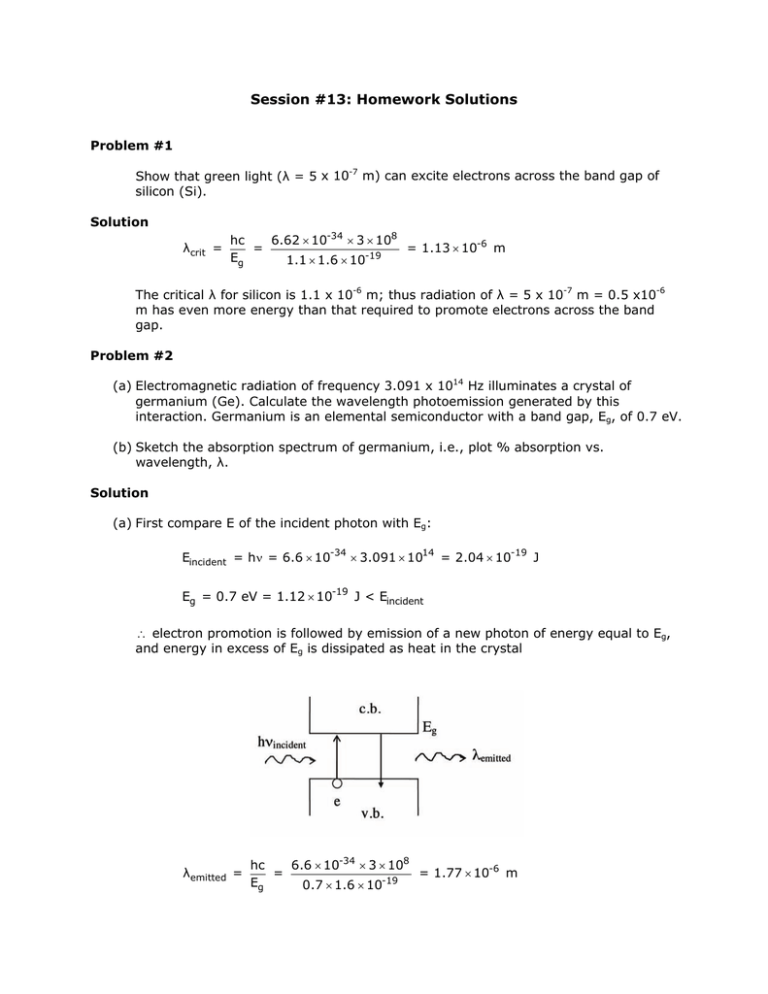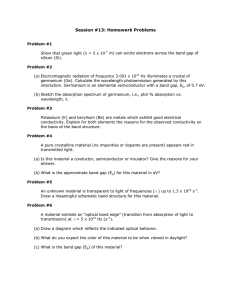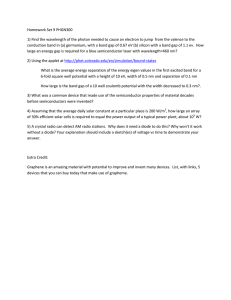Session #13: Homework Solutions
advertisement

Session #13: Homework Solutions Problem #1 Show that green light (λ = 5 x 10-7 m) can excite electrons across the band gap of silicon (Si). Solution λcrit = hc 6.62 × 10-34 × 3 × 108 = = 1.13 × 10-6 m Eg 1.1 × 1.6 × 10-19 The critical λ for silicon is 1.1 x 10-6 m; thus radiation of λ = 5 x 10-7 m = 0.5 x10-6 m has even more energy than that required to promote electrons across the band gap. Problem #2 (a) Electromagnetic radiation of frequency 3.091 x 1014 Hz illuminates a crystal of germanium (Ge). Calculate the wavelength photoemission generated by this interaction. Germanium is an elemental semiconductor with a band gap, Eg, of 0.7 eV. (b) Sketch the absorption spectrum of germanium, i.e., plot % absorption vs. wavelength, λ. Solution (a) First compare E of the incident photon with Eg: Eincident = hν = 6.6 × 10-34 × 3.091 × 1014 = 2.04 × 10-19 J Eg = 0.7 eV = 1.12 × 10-19 J < Eincident ∴ electron promotion is followed by emission of a new photon of energy equal to Eg, and energy in excess of Eg is dissipated as heat in the crystal λemitted = hc 6.6 × 10-34 × 3 × 108 = = 1.77 × 10-6 m -19 Eg 0.7 × 1.6 × 10 (b) λedge = λemitted as calculated in part (a) = 1.77 μm Problem #3 Potassium (K) and beryllium (Be) are metals which exhibit good electrical conductivity. Explain for both elements the reasons for the observed conductivity on the basis of the band structure. Solution E • } • • • 4s band half filled E diagram for K E 3d band empty • •• • E diagram for Be dist. } } 2p overlapping 2s filled dist. In K, each atom contributes one electron and one orbital to the conduction band (4s band). According to the Pauli exclusion principle, each “molecular orbital” formed in the band (energy state) can accommodate two electrons. As a consequence, the conduction band is only half–filled with electrons – which provides for electrical conduction. In Be, each atom contributes two electrons and one orbital to the conduction band (2s band). With two electrons per orbital (from each atom) the 2s conduction band is filled. The observed electrical conductivity is due to the overlapping 2p band, which is empty and thus provides empty energy states required for electronic conduction. Problem #4 A pure crystalline material (no impurities or dopants are present) appears red in transmitted light. (a) Is this material a conductor, semiconductor or insulator? Give the reasons for your answer. (b) What is the approximate band gap (Eg) for this material in eV? Solution “White light” contains radiation in wavelength ranging from about 4000 Å (violet) to 7000 Å (deep red). A material appearing red in transmission has the following absorption characteristics: (a) If the material is pure (no impurity states present), then it must be classified as a semiconductor since it exhibits a finite “band gap” – i.e. to activate charge carriers, photons with energies in excess of “red” radiation are required. (b) Taking λ = 6500 Å as the optical absorption edge for this material, we have: E= hc 1 eV = 3.05 × 10-29 J × = 1.9 eV λ 1.6 × 10-19 J Accordingly, the band gap for the material is Eg = 1.9 eV. Problem #5 An unknown material is transparent to light of frequencies ( ν ) up to 1.3 x 1014 s–1. Draw a meaningful schematic band structure for this material. Solution Since E = hν, we find the material to be transparent to photons with energies less than: (6.63 × 10-34 J ⋅ s) × (1.3 × 1014 s-1 ) × 1 eV 1.6 × 10-19 J = 0.54 eV This constitutes the absorption edge, i.e. the energy band gap. E conduction band Eg = 0.54 eV valence band Problem #6 A material exhibits an “optical band edge” (transition from absorption of light to transmission) at ν = 5 x 1014 Hz (s–1). (a) Draw a diagram which reflects the indicated optical behavior. (b) What do you expect the color of this material to be when viewed in daylight? (c) What is the band gap (Eg) of this material? Solution (a) λ = c 3 × 108 m/s = = 6 × 10-7 m = 600 nm ν 5 × 1014 s−1 (b) The color will be orange or “reddish”. (c) Eg = Ephoton = hν = 6.63 × 10-34 J ⋅ s × 5 × 1014 Hz = 3.315 × 10−19 J × 1 eV 1.6 × 10-19 J = 2.07 eV MIT OpenCourseWare http://ocw.mit.edu 3.091SC Introduction to Solid State Chemistry Fall 2009 For information about citing these materials or our Terms of Use, visit: http://ocw.mit.edu/terms.



